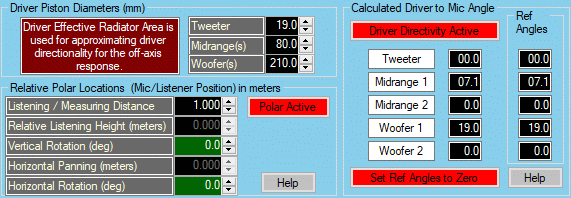Introduction
Loudspeaker drivers are directional, that is, they do not radiate sound uniformly. The SPL is a result of both angle and frequency. As angle increases, the output generally decreases. The amount is not universal among drivers as well, so assumptions must be made in an attempt to estimate the impact. For those interested in the specifics, a modified (by magnitude multiplier) Bessel function is used. Keep in mind that this is a very simplistic assumption, but the issues of driver axial SPL response are complex and not within the scope of software such as WinPCD or most design software to model for that matter.
In WinPCD, Polar Active must be set for any off-axis calculations to be enabled. This includes both crossover and driver effects. If you use direct measurements that are not minimum-phase, do not set it active. All off-axis calculations will not be accurate.
The driver-to-mic angles are calculated. They are determined using the current position of the mic (listening position) values in the Relative Polar Locations group and the Baffle Geometry group values for the drivers. As the mic is rotated using the vertical or horizontal scrollers in the Relative Polar group, the mic (x,y,z) values are updated and the mic-to-driver angles are adjusted accordingly.
Set Angles as Reference
The purpose of the reference angles is to have a reference of the original measurement axis for all subsequent off-axis calculations. There are two situations. The first case is that they were taken independently on each individual driver axis. The other and most common case is that all measurements were taken at the same mic location.
If each one was taken on the individual driver axis, then the reference angles should be left at zero. This is essentially a special case with the added difficulty of how one would determine relative acoustic offset. This case will be ignored as it's an unlikely scenario with its own difficulties.
More likely, all measurements were taken at the same mic location. In this case, the measured response includes off-axis effects for each driver at that location. There are still two considerations now. One is that the direct (unprocessed) measurements will be used. The other is that these measurements were post-processed to produce minimum-phase files.
If direct (unprocessed) measurements are used, do not use any polar options at all. This includes leaving all Baffle Geometry settings at zero. The results will only be valid for the measurement point. Go no further.

Setting and Using the Reference Angles
If the measurements are all minimum-phase post-processed files taken from one mic position, then the reference angles should be set. What follows describes how the reference angles are set and used in calculation of the off-axis relative to the original measurement position. To set the reference angles take the following steps.
From this point on, do not change the Ref Angles values. All off-axis calculations will be based on these.
Driver Diameter Effects
The driver diameter settings may be left at zero. In this case, the off-axis calculations will only show the influence of the crossover. No corrections for driver diameter will be made.
When the driver diameters are set, the summed response will include any changes in SPL response due to angle from the Reference Angle settings in relation to diameter. Here is where it gets a bit complicated.
In previous releases of WinPCD, any change in angle from the original default position of a driver showed a drop in magnitude. However, consider that if all measurements were taken from the same mic position, drivers not on the mic axis already are off-axis. That is, they likely already have some rolloff dependent on the driver's angle and diameter. What this means is that if the mic is rotated such that the driver-to-mic angle decreases, the magnitude should increase. The magnitude should decrease only if the driver-to-mic angle is larger than the Reference Angle, hence the need to properly set the angle.
Consider a typical 2-way or 3-way with the measurements taken on the tweeter axis with woofer and/or midrange below the tweeter. The tweeter on-axis vector coincides with the mic vector initially. The Reference Angle is the default starting point for each driver. Rotate the mic down. Initially the driver-to-mic angle to the next driver below the tweeter will be decreasing, so that particalur driver's SPL magnitude response will be increasing until the mic is directly in front of that driver. Rotate the mic down further, to points below that driver, and the SPL magnitude will be decreasing. The ability to predict this off-axis behaviour requires a Reference Angle in order to be accurate, or at least as accurate as the assumptions made will allow.